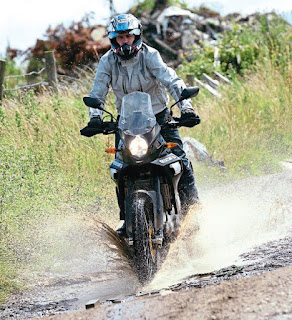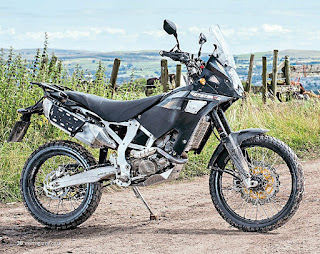If there was ever a story in the motorcycle industry of survival against all odds, there would be none to rival that of Clews Competition Machines. Founded in 1971 by Lancashire man Alan Clews, the company was born out of Alan’s frustration at not being able to buy a works BSA Scrambler. As a talented bike builder himself, he set about building his own machine, stretching a 441cc Victor engine to 490cc by increasing the stroke from 90mm to 100mm. He never intended to turn it into a business, but such was the demand that two years later CCM had turned out almost 140 machines.
Success came and went over the years. In the Eighties the company was taken over by automotive giant Armstrong Equipment Ltd. There was a switch to Rotax engines, with the MT500 military bikes complementing a line-up of scramblers and trials bikes. By 1987 the relationship had soured, and CCM and Armstrong went their separate ways. A few years in the shadows was followed by a 597cc Rotax-powered C25 motocross bike and the R30 Supermoto. There was a switch to Suzuki engines and the arrival of venture capitalists Peter Swift and Richard Robson; the new money brought new bikes as well as new conflicts, with Alan buying the company he founded back off the investors in 2004.
This renaissance gave us the FT35 Flat Tracker, the CR40 and the CMX450 motocross bike.The company then began buying in and shipping out modified Chinese bikes for various military forces around the world, badged as the MT230.
In recent years CCM decided it would need a year-round bike to complement the supply of military machines, and settled upon the idea of building a lightweight alternative to the ever-expanding waistline of the adventure bike market. The result is the CCM GP450 Adventure.
Enduro Power !
Historically, CCM has always relied on third party engines, and the CCM GP450 is no different. The motor here is the liquid-cooled 449.5cc single-cylinder from the now discontinued BMW G450X (the engine produced on licence by Kymco), which in its original form produced 52 HP. Originally designed for competitive enduro racing, it’s been detuned, with peak revs reduced from 9500 RPM to 7500 RPM, and power now rated at 40 HP.
In its original state of tune the engine would require a full strip down after 40 hours of racing. Now, with the reduced power output and less rigorous demands of the road, service intervals are 5000 miles for oil, filter and a valve check. You can purchase a power plug to take it back up to 52 HP, but that does invalidate your warranty. Some have questioned the appropriateness of this engine for long distance travel, particularly with its original one litre oil capacity and the absence of an oil reservoir. Having ridden the bike for approximately 1000 miles for the purpose of this test, I can only tell you that there had been no noticeable drop in fluid levels.
Torque is the CCM GP450 engine’s greatest strength, pulling cleanly in fifth gear from as low as 25mph. Maximum speed is around 95 mph, with a comfortable cruising speed of 65-70 mph. Some complaint has also been levelled at the five-speed gearbox, suggesting a six-speed ’box would have been preferred.
It was certainly possible, as when Husqvarna used the engine in its 449 enduro bike, it came with fitted with a six-speed gearbox (as well as a hydraulic clutch). Instead, CCM GP450 opted for the five-speed BMW application. As an experiment (he believes a successful one), one CCM owner has already set about modifying the ratios, with a lower first, and a taller fourth and fifth. Personally, I believe that the five you get are fine; well spaced with a very smooth, clutchless change.
At motorway speeds the bike’s not revving uncomfortably high (the absence of a rev counter makes it difficult to record accurately), yet still with enough roll-on power for overtaking. There are some vibrations – to be expected on a single – that can seem unpleasant at first, though they’re mainly through the footpegs, particularly on the transmission side. You find that with a thin trials-style boot the vibrations can become too intrusive over a long distance, but a thicker sole certainly helps, as does time on the bike, with you noticing it less with every mile.
The CCM GP450 will all too easily die on a part or closed throttle at low revs – it catches you out at first, and the remedy of course is to feather the clutch. Once you’re acclimatised to it, it’s fine, and to be fair, as long as you’re on the throttle the bike will pull smoothly from very low down in the revs. With 40bhp there isn’t a big wallop of power, so it’s never going to catch you out, but with the old fashioned cable operation – a welcome return over the snatchy ride-by-wire systems of many new adventure bikes – you can easily feel the delivery of power through the back wheel. The bike never feels truly fast, but it’s certainly very brisk.
Refreshingly Light !
One of the interesting features of the CCM GP450 is the front sprocket mounted on the swingarm pivot. It was designed this way for the G450X, the intention being to keep the chain under a constant tension, regardless of suspension activity, delivering constant drive to the rear wheel.
Some enduro riders didn’t care for the idea and it’s not been widely adopted. On the CCM GP450 it serves as a point of interest as much as a benefit or flaw. Of course, the bike’s greatest strengths is its refreshing lightness; low speed manoeuvring, and even getting the bike in and out of the garage is a treat. On the move the bike flows, is no hassle to corner, with good composure under braking from the very impressive single 320mm disc and Brembo caliper. You could see how – with a set of 17in wheels and road biased tyres – the bike could make a very enjoyable, and manageable, supermoto.
But it’s off the road where the CCM GP450 really begins to shine. The lack of weight, mated to the clean power delivery, well set up Tractive rear suspension and Marzocchi front forks means the CCM GP450 rides like a well-mannered enduro machine converted for the road, rather than a road bike converted for the dirt. It’ll also take a good knock from a fall (a wing mirror the only victim in this assessment) and in being so light is easily picked up.
The CCM GP450 is confusing in a sense, being pinned as an adventure bike. At first you judge it as one intended for road use, and in returning a genuine 200 miles from the 20-litre tank you begin to consider the distances you could travel on it. But then you ride it off-road, and you realise that actually the strength of this bike is being able to spend a day or so exploring your local environment, riding the green lanes and trails, and doing so with all the comfort of a well padded seat and good fuel range.
You don’t need to go far on this CCM GP450 to get the best from it. To label it a "leisure bike", rather than "adventure bike", would perhaps be more realistic, and in doing so remove some of the pressure to perform over a long distance, something few owners will do with it anyway. Seat height options also go as low as 790mm, achieved through a combination of a low seat and altered suspension.
Economy of Scale
As a trail bike to have in your garage for a bit of Sunday fun it’s hard to think of anything that comes close. A KTM 690 would be more savage, but not as liveable. A Honda CRF250 would be cheaper but far from being as agile or capable. A Yamaha Tenere 660 would feel cumbersome by comparison, and a second-hand Suzuki DRZ400 would be closer to the CCM GP450, but still not in the same league for agility.
A large part of that agility comes from the "BondLite" frame – CCM’s own technology – which in essence sees the bonding together of cast aluminium bones to give an incredibly light, yet strong skeleton. The frame is also bolted, but not said to be necessary such is the strength of the glue. The BondLite technique was first used on the company’s RMX450 motocross bike of 1997, and goes some way to explaining why the CCM GP450 is such a good offroad machine.
The CCM GP450 is not perfect; the speedo is slow to respond, and jumps from figure to figure. There’s no centrestand (though it is an option), which is a problem if you’re needing to repair a tyre in the wild. Even checking the oil sight glass on the right is tricky, as the sidestand flicks up as soon as pressure is taken off it. This is a result of the engine not being designed with a kill-switch – a legal requirement to guard against riding off with the stand still down – and it being too costly to reverse engineer one. But these are just niggles, and a consequence of small volume production.
At £7999, some perceive this to be too much for a 450cc machine, particularly when a Triumph or BMW 800 can be bought for only a little more. The reality of course is that a handbuilt bike, with limited economies of scale, high-end components, and some really lovely design touches is never going to be as cheap as a mass-produced product.
Keith Bontrager’s famous saying; "Strong, light, cheap; pick two," certainly rings true here.
For those looking for something light, loveable and different, then the CCM GP450 Adventure is certainly worth heading up to Bolton for a test ride. It won’t be for everyone, but it could very well be for you.
CCM GP450 Specs and Price
Engine : Four stroke, Single-Cylinder, DOHC 16-Valve (Titanium), Liquid-Cooled
Capacity : 449.5 cc
Bore x Stroke : 98 x 59.6 mm
Induction : Fuel Injection
Max Power : 40 HP @ 7.000 RPM
Max Torque : 42.8 N.m @ 6.500 RPM
Transmission / Drive : 5-Speed / Chain
Frame : "BondLite" Forged Alumunium Frame
Front Suspension : 47 mm Upside Down Forks, 18 Stages Rebound Damping, 12 Stages Compression
Rear Suspension : Linkage Monoshock, Adjustable Preload, 12 Stages Rebound Damping, 24 Stages Compression
Front Brakes : Single 320 mm Disc, Brembo Calipers
Rear Brakes : Single 240 mm Disc, Brembo Caliper
Front Tyre : 90/90 - 21 TT Dunlop Trailmax
Rear Tyre : 120/90 - 18 TT Dunlop Trailmax
Wheelbase : 1.510 mm
Seat Height : 890 mm
Dry Weight : 125 Kg
Fuel Capacity : 20 Litres
Price : £7995





